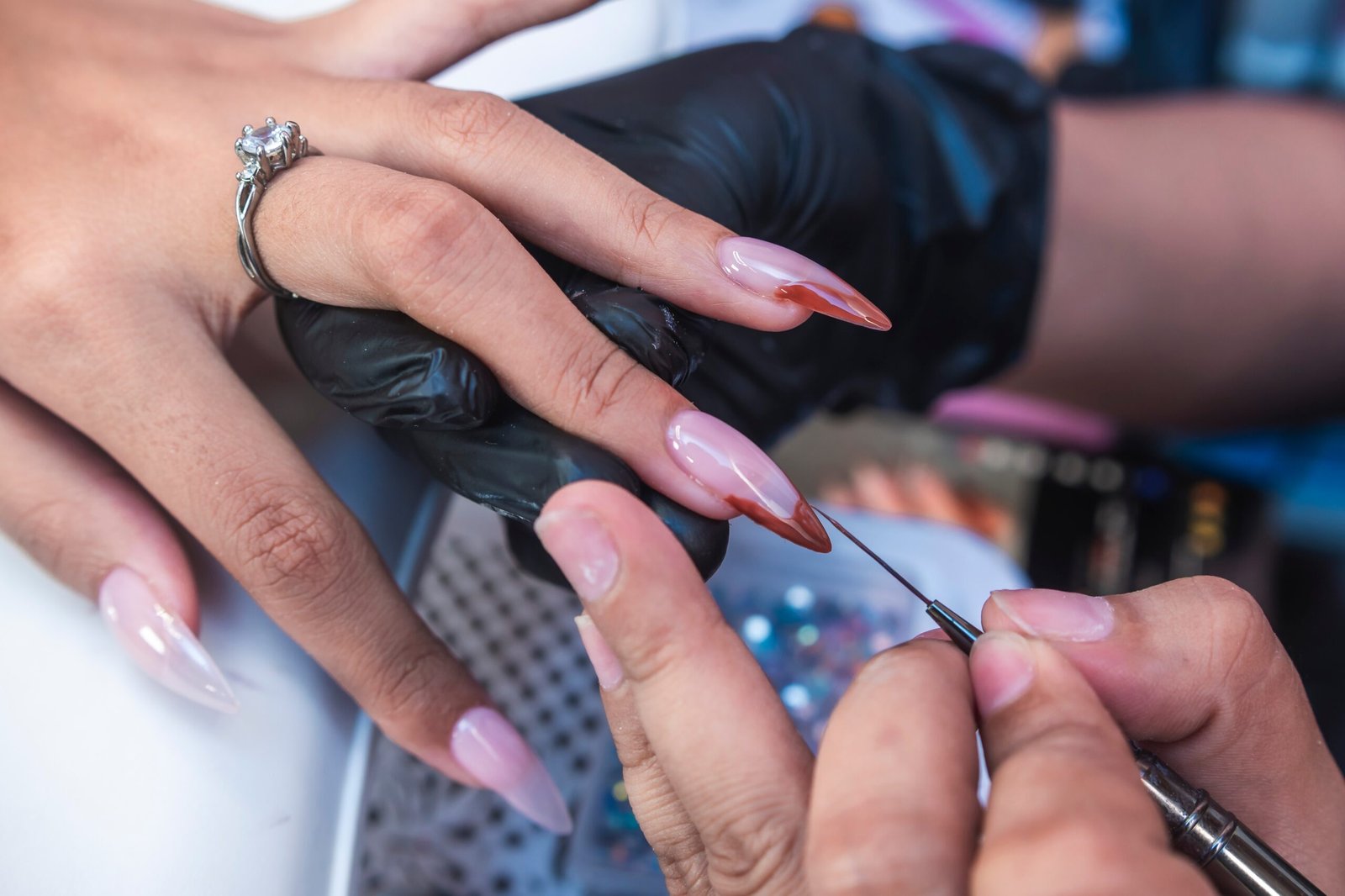You’ve probably admired those gorgeous, glossy nails that seem to last forever without a single chip. That’s the magic of gel polish! But lately, you might be wondering: is gel nail polish bad for your nails?
Let’s dive deep into everything you need to know about gel manicures, so you can make an informed decision that’s right for your lifestyle and nail health.

What Is Gel Nail Polish?
Think of gel nail polish as the superhero version of regular polish. While traditional nail polish air-dries, gel polish needs to be “cured” under UV or LED lights to harden completely.
This curing process is what makes gel polish so different from regular nail polish and acrylic nails. Regular polish simply dries through evaporation, while acrylics use a chemical reaction with liquid and powder. Gel polish, on the other hand, uses light to activate special polymers that create that rock-hard, glossy finish.
Gel Nail Polish Pros and Cons
Let’s be real – every beauty treatment has its ups and downs. Here’s what we’ve observed after years of perfecting gel manicures at our Corona salon:
The Amazing Benefits:
- Glossy finish that lasts: Your nails look freshly painted for 2-3 weeks
- Long wear time: No more weekly touch-ups or chipped polish disasters
- Time-saving: Once it’s done, you’re good to go for weeks
- Instant dry: Walk out of the salon without worrying about smudges
The Not-So-Great Parts:
- Higher cost: Gel manicures typically cost more than regular polish
- Nail damage risk: Improper application or removal can harm your natural nails
- Difficult removal: You can’t just peel it off like regular polish
How Gel Nail Polish Can Affect Your Nail Health
UV/LED Lamp Exposure Concerns
Those bright lights aren’t just for show. UV and LED lamps emit radiation similar to tanning beds, though at much lower levels.
However, the exposure time is relatively short – usually just 30-60 seconds per coat. Still, it’s something to be aware of, especially if you’re getting gel manicures frequently.
Nail Bed Damage
When gel polish is applied incorrectly or removed improperly, it can cause:
- Peeling of the nail surface: Over-filing or aggressive removal strips away layers of your natural nail
- Thinning: Repeated harsh treatment weakens your nails over time
- Brittleness: Nails become more prone to breaking and splitting
Cuticle and Skin Irritation
Sloppy application can lead to gel polish touching your skin, which may cause irritation or allergic reactions. We always make sure to keep the polish on your nails, not your cuticles!
Harsh Chemicals and Allergens
Gel polishes contain chemicals like HEMA (hydroxyethyl methacrylate) and various acrylates that can trigger allergic reactions in some people. Additionally, the acetone used for removal can be quite drying.
Removal Risks
This is where most nail damage actually happens. Peeling, scraping, or over-buffing during removal can seriously harm your natural nails. We’ve seen clients come in with severely damaged nails because they tried to remove gel polish at home incorrectly.
Short-Term vs Long-Term Gel Polish Use
Is gel nail polish bad for your nails if you only do it occasionally? Generally, no! Getting gel manicures once in a while – say, for special events or vacations – is usually fine for most people.
The problems typically arise with back-to-back gel manicures over extended periods. Your nails need time to breathe and recover between applications.
When Gel Becomes Too Much:
- You’re getting gel manicures every 2-3 weeks for months without breaks
- Your natural nails feel thin, weak, or painful
- You notice white spots, ridges, or discoloration
- Your nails start breaking more easily than usual
We generally recommend taking a break every 3-4 gel applications to let your nails recover.
How to Prepare Your Nails Before Gel Application
Proper preparation is key to minimizing gel manicure risks. Here’s our professional nail prep checklist:
Pre-Application Steps:
- Hydrate your cuticles: Use cuticle oil 24-48 hours before your appointment
- Avoid over-buffing: Light buffing is enough – aggressive filing weakens nails
- Insist on a protective base coat: This creates a barrier between your natural nail and the gel
- Communicate any concerns: Tell your nail tech about allergies or sensitivities
Red Flags to Watch Out For:
- Excessive filing or buffing of your natural nails
- Skipping the base coat
- Rushing through the prep process
- Using tools that haven’t been properly sanitized
How to Reduce the Risks of Gel Manicures
You don’t have to give up gel nails entirely! Instead, let’s talk about smart ways to minimize the risks:
UV Protection Strategies:
- Apply broad-spectrum sunscreen to your hands 20 minutes before your appointment
- Choose LED lamps over traditional UV lamps when possible (they cure faster with less exposure)
- Consider fingerless UV-protective gloves designed for nail appointments
Safe Removal Practices:
- Never, ever peel or pick off gel polish – this is the fastest way to damage your nails
- Always have gel polish professionally removed or follow proper at-home removal techniques
- If removing at home, soak in acetone-soaked cotton balls wrapped in foil for 10-15 minutes
Strengthening Products We Recommend:
- Cuticle oils with vitamin E or jojoba oil
- Nail strengthening treatments with biotin
- Dermatologist-approved moisturizing creams for hands and nails
How to Care for Nails After Gel Removal
Immediate Post-Removal Care:
- Apply a rich hand cream or cuticle oil immediately
- Use a nail strengthening treatment designed for post-gel recovery
- Avoid harsh chemicals and excessive water exposure for the first few days
Nail Recovery Supplements: While results vary, some people find these helpful:
- Biotin: May support nail strength and growth
- Collagen: Could help with overall nail health
- Vitamin E: Supports nail and cuticle health
When to Take a Break: Give your nails a rest if you notice:
- Splitting or cracking
- Soreness or sensitivity
- Deep ridges or discoloration
- Unusual thinness or flexibility
Generally, a 1-2 week break between gel applications gives your nails time to recover.
Final Thoughts
So, is gel nail polish bad for your nails? The answer isn’t black and white. Like many beauty treatments, gel polish comes with both benefits and risks.
The key is finding the right balance for your lifestyle and nail health. With proper preparation, professional application, careful removal, and occasional breaks, most people can enjoy gel manicures safely.
At Double OO Nails & Spa in Corona, CA we’re committed to helping you achieve beautiful nails while prioritizing your health. We use the latest techniques and highest-quality products to minimize risks while maximizing results.
Ready to experience the safest, most beautiful gel manicure in Corona? Visit us at Double OO Nails & Spa, where your nail health and satisfaction are our top priorities. Let our experienced technicians help you enjoy gorgeous gel nails while keeping your natural nails healthy and strong!
FAQs
Is gel polish worse than acrylics?
Both have risks, but gel polish is generally considered gentler than acrylic extensions. Acrylics require more aggressive filing and can cause more structural damage.
How often should you give your nails a break?
We recommend a 1-2 week break every 3-4 gel applications to let your nails recover and breathe.
Is gel polish safe for teenagers?
Yes, but we recommend starting with occasional use rather than regular applications, as teenage nails are still developing.


